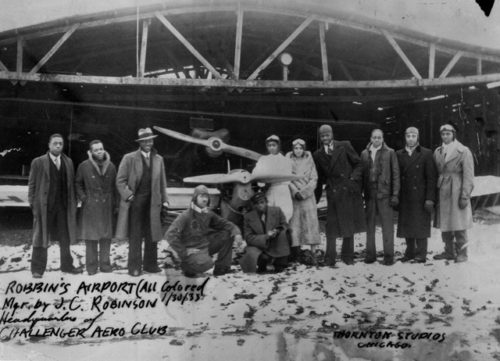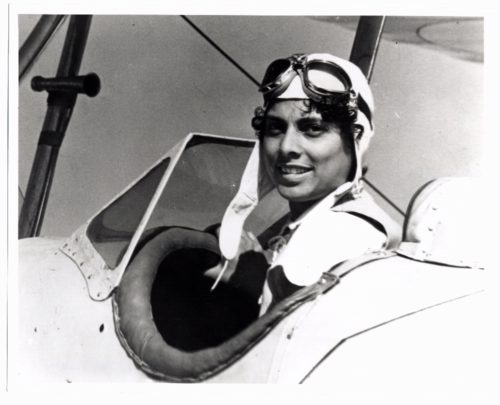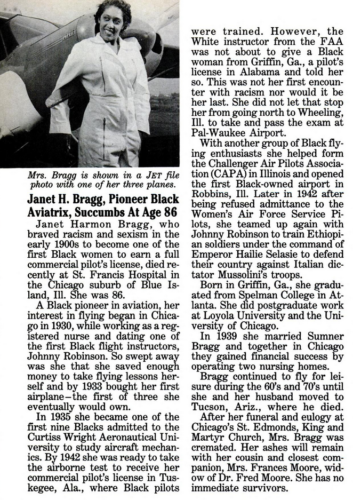
It is a fine story on its own, not to mention the wider story of emancipation of black women from colonialism, but unfortunately it obscures the many women who flew in Africa long before her. I think it fair to say Ghana in 1963 was most certainly thinking about at the Ethiopian Air Force of 1935, and the role of women there.
First, let me lay out the situation globally for women who were pilots by the 1930s.
Bessie Coleman was the first American to have an International Pilot’s license. Racism in America actively prevented a black and Native American woman to learn how to fly, so she took night school to learn French, went to France and quickly became a pilot there.
…her brothers served in the military during World War I and came home with stories from their time in France. Her brother John teased her because French women were allowed to learn how to fly airplanes and Bessie could not… Coleman was accepted at the Caudron Brothers’ School of Aviation in Le Crotoy, France. She received her international pilot’s license on June 15, 1921 from the Fédération Aéronautique Internationale.
Just to reiterate, Coleman was the first American of any race or gender to achieve an International Pilot’s license.
Willa Beatrice Brown also is an American remembered for achieving many firsts: she was the first black woman with a mechanic’s license 1935, first black woman with a private pilot’s license 1938, and first black woman with a commercial pilot’s license 1939.

Brown trained hundreds of black American pilots, including some who went on to serve in the US military during WWII. She also was one of the eight black pilots that Ethiopia intended to get military support from to help fight against fascist invasion from Italy.
Second, Brown’s story reveals another thread — Ethiopia’s sense of equality at that time. It was a place with women flying planes years before Danquah was even born. And since that’s a giant clue about history of women pilots in Africa, let’s pull on the thread a little.
Italy invaded Ethiopia on October 3, 1935. Italian fascists (similar to the KKK in 1921 using planes to firebomb Tulsa, Oklahoma) launched a series of bombing runs to drop chemical weapons on Ethiopian civilians (even targeting clearly marked medical facilities).
It was in context of this air war, as well as 1921 the KKK using aircraft to bomb Tulsa, that we have to think of a black woman pilot like Janet Bragg being refused a role in US military because of racism.
She was invited by Emperor Selassie to Ethiopia (we know officially in 1955, although hard to find documentation of earlier visits).

The Chicago Challenger Air Pilot Association (CAPA), aiding in building an Ethiopian Air Force, was in fact founded by Bragg (see again the photo at the start of this post) where she maintained a very high-profile role including a public newsletter.
While doing postgraduate work at Loyola University and the University of Chicago, she worked as a registered nurse at several hospitals and saved enough money to buy her first of three planes. For $500 she purchased a plane, which she shared with other flying enthusiasts. This group, inspired by Bessie Coleman, formed the Challenger Air Pilots Association, which later evolved into the Coffey School of Aeronautics.
More to the point, we have evidence the President of CAPA — John Robinson — was physically in Ethiopia 1935 to advise Selassie when Italy invaded.
Was Bragg there too?
Did the CAPA women fly in Ethiopia to help build an Air Force that could fight fascism? They certainly were pilots considered instrumental in training male pilots and supporting Air Force development in both America and Ethiopia at this time, so it is not implausible.
This is a line of inquiry worth investigating further. And on that note, it would provide some evidence that America’s air force dramatic build-up the 1940s to fight against fascism would be rooted in the efforts of black women in the 1930s.
Third, the CAPA aviators in Ethiopia were able to escape back to America to avoid capture by Italy. Yet we know today America really should have been backing these black pilots flying in Africa at this time and sending them back in with the British forces in 1940 (instead of waiting until Operation Torch 1942 and then not using them at all).
Indeed, American black pilots achieving record-breaking feats were far more likely to find themselves recruited to fight against fascism by Africa itself, than allowed to fight for America to free Africa.
Although Julian never succeeded in flying across the Atlantic, his efforts made him an international celebrity, and in 1931 Emperor Haile Selassie invited him to Ethiopia to take part in his coronation ceremonies. Julian impressed the Emperor with his skills as a parachutist, landing within a few feet of his throne during one ceremony, a feat that won him Ethiopian citizenship and a position in the nation’s airforce. […] During the Italian invasion of Ethiopia in 1935, Julian flew to Ethiopia to aid in the defense of Selassie’s government. He was put in command of the Imperial Ethiopian Air Force, which at the time consisted of 3 planes. Upon his return to the United States, he was temporarily detained at Ellis Island, over the question of his nationality — British or Ethiopian.
Of course that brings forward the rather awkward fact revealed by the British Foreign Office that some in the American government actively tried to undermine American blacks aiding Ethiopia and keep them home.
One distressed American official [November 1935] asked the State Department to investigate… and to discourage American blacks from going to Ethiopia.
When I studied Ethiopian history in British government archives, I read about women flying there in even the very first years of airplane availability (1920s). Perhaps with some time, and better availability of archives online, someone will focus on an important chapter of history that appears long overdue for greater exposure.
Please keep in mind (as an end note on where to learn more about these amazing women) I’ve written before about Wikipedia integrity issues, such as strange tone and lack of accuracy, and this history of black women in aviation is no exception.
You’ll find Wikipedia pages that claim impossibly that both Willa Brown and Janet Bragg were the “first” black woman to earn their commercial pilot’s license, and no reference at all to the racism they faced.
Here’s how the Smithsonian easily puts the Wikipedia integrity issues to rest. Brown was able to get a commercial license in 1939, whereas Bragg was denied a commercial license in the 1930s solely because she was black:
Bragg encountered discrimination against women at the Tuskegee black pilot training school when she passed the flight test for her commercial license and was denied the license. She received her commercial license in 1943 at the Pal-Waukee Airport near Chicago.
I don’t know what is worse, that Wikipedia omits the racism they faced, fails to recognize these two women existed during the same period and thus couldn’t both be the first, or gets a date wrong. It’s easy to fixate on the last point (easy to fix a date) yet the former issues are really more of an ongoing problem I find with Wikipedia.

